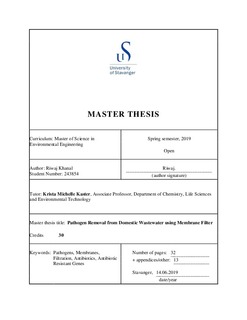| dc.description.abstract | The study assessed the use of membrane filter for the removal of harmful pathogens and other microorganisms from domestic wastewater. Effluent wastewater from the UASB reactor was used as feed for the membrane filter. The feed, permeate and retentate sample from the filter was collected and was analyzed for the presence of microbial community. The pathogens analyzed were Total coliform. E. coli, enterococcus and other heterotrophic organisms. Chromogenic selective agar was used as the media for total coliform, Slanetz-Baintley selective agar for enterococcus and Plate-count agar was used for the heterotrophs. The enterococcus colony was confirmed using Bile-Esculin selective agar for enterococcus. The process was repeated for four different samples run through three different filter operation modes: conventional micro filter, dead-end and cross-flow mode. The micro filter was ceramic tubular membrane with pore size 0.1 µm. the dead end filter was a silicon-carbide flat sheet membrane with pore size 0.1 µm. the cross-flow was a flat-sheet polymeric membrane with pore size 0.1 µm. The results from all the filter operation were evaluated for the performance based on the removal percentage of the pathogens. Overall, the membranes were very effective in the removal of pathogens with 90 % removal efficiency with most of the membranes. Out of the three operation modes, cross flow mode was found to be the most effective one.
Not only that, the membrane filters were used for the removal of the ARGs and the results were analyzed qualitatively using PCR. Sulfamethoxazole, tetracycline and erythromycin were the antibiotics chosen for the study. sulI, sulII and sulIII were considered for sulfamethoxazole, tetA, tetB, tetC, tetD, tetE, tetO, tetG, tetK, tetL, tetM and otrB for tetracycline and ermA, ermB, ermC and msrA were considered for erythromycin resistant genes. The genes above were subjected to PCR for amplification. The resulting solution was run in 1% gel for 60 minutes in 100V. The result showed the membrane was not very effective in the removal of the ARGs except for some tetracycline genes which seem to be retained by the membrane. All three filter modes were used for ARGs as well and the cross flow mode seemed to be the most effective one. Since the study was a qualitative one, the efficiency of the filter in removal of the ARGs could not be exactly reported. | nb_NO |
